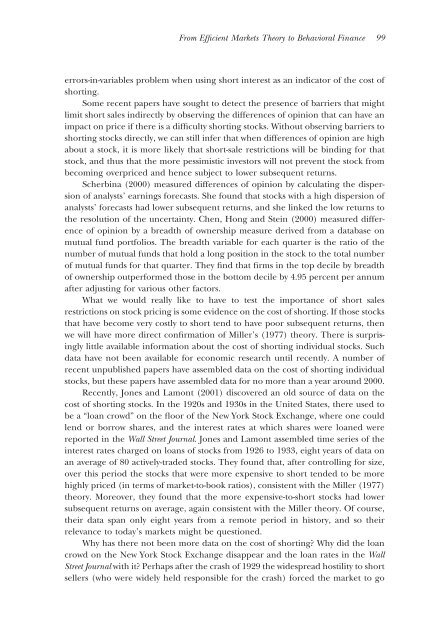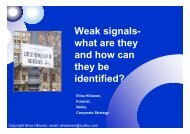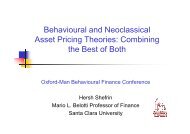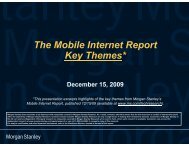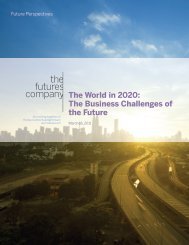From Efficient Markets Theory to Behavioral Finance
From Efficient Markets Theory to Behavioral Finance
From Efficient Markets Theory to Behavioral Finance
You also want an ePaper? Increase the reach of your titles
YUMPU automatically turns print PDFs into web optimized ePapers that Google loves.
<strong>From</strong> <strong>Efficient</strong> <strong>Markets</strong> <strong>Theory</strong> <strong>to</strong> <strong>Behavioral</strong> <strong>Finance</strong> 99<br />
errors-in-variables problem when using short interest as an indica<strong>to</strong>r of the cost of<br />
shorting.<br />
Some recent papers have sought <strong>to</strong> detect the presence of barriers that might<br />
limit short sales indirectly by observing the differences of opinion that can have an<br />
impact on price if there is a difficulty shorting s<strong>to</strong>cks. Without observing barriers <strong>to</strong><br />
shorting s<strong>to</strong>cks directly, we can still infer that when differences of opinion are high<br />
about a s<strong>to</strong>ck, it is more likely that short-sale restrictions will be binding for that<br />
s<strong>to</strong>ck, and thus that the more pessimistic inves<strong>to</strong>rs will not prevent the s<strong>to</strong>ck from<br />
becoming overpriced and hence subject <strong>to</strong> lower subsequent returns.<br />
Scherbina (2000) measured differences of opinion by calculating the dispersion<br />
of analysts’ earnings forecasts. She found that s<strong>to</strong>cks with a high dispersion of<br />
analysts’ forecasts had lower subsequent returns, and she linked the low returns <strong>to</strong><br />
the resolution of the uncertainty. Chen, Hong and Stein (2000) measured difference<br />
of opinion by a breadth of ownership measure derived from a database on<br />
mutual fund portfolios. The breadth variable for each quarter is the ratio of the<br />
number of mutual funds that hold a long position in the s<strong>to</strong>ck <strong>to</strong> the <strong>to</strong>tal number<br />
of mutual funds for that quarter. They find that firms in the <strong>to</strong>p decile by breadth<br />
of ownership outperformed those in the bot<strong>to</strong>m decile by 4.95 percent per annum<br />
after adjusting for various other fac<strong>to</strong>rs.<br />
What we would really like <strong>to</strong> have <strong>to</strong> test the importance of short sales<br />
restrictions on s<strong>to</strong>ck pricing is some evidence on the cost of shorting. If those s<strong>to</strong>cks<br />
that have become very costly <strong>to</strong> short tend <strong>to</strong> have poor subsequent returns, then<br />
we will have more direct confirmation of Miller’s (1977) theory. There is surprisingly<br />
little available information about the cost of shorting individual s<strong>to</strong>cks. Such<br />
data have not been available for economic research until recently. A number of<br />
recent unpublished papers have assembled data on the cost of shorting individual<br />
s<strong>to</strong>cks, but these papers have assembled data for no more than a year around 2000.<br />
Recently, Jones and Lamont (2001) discovered an old source of data on the<br />
cost of shorting s<strong>to</strong>cks. In the 1920s and 1930s in the United States, there used <strong>to</strong><br />
be a “loan crowd” on the floor of the New York S<strong>to</strong>ck Exchange, where one could<br />
lend or borrow shares, and the interest rates at which shares were loaned were<br />
reported in the Wall Street Journal. Jones and Lamont assembled time series of the<br />
interest rates charged on loans of s<strong>to</strong>cks from 1926 <strong>to</strong> 1933, eight years of data on<br />
an average of 80 actively-traded s<strong>to</strong>cks. They found that, after controlling for size,<br />
over this period the s<strong>to</strong>cks that were more expensive <strong>to</strong> short tended <strong>to</strong> be more<br />
highly priced (in terms of market-<strong>to</strong>-book ratios), consistent with the Miller (1977)<br />
theory. Moreover, they found that the more expensive-<strong>to</strong>-short s<strong>to</strong>cks had lower<br />
subsequent returns on average, again consistent with the Miller theory. Of course,<br />
their data span only eight years from a remote period in his<strong>to</strong>ry, and so their<br />
relevance <strong>to</strong> <strong>to</strong>day’s markets might be questioned.<br />
Why has there not been more data on the cost of shorting Why did the loan<br />
crowd on the New York S<strong>to</strong>ck Exchange disappear and the loan rates in the Wall<br />
Street Journal with it Perhaps after the crash of 1929 the widespread hostility <strong>to</strong> short<br />
sellers (who were widely held responsible for the crash) forced the market <strong>to</strong> go


